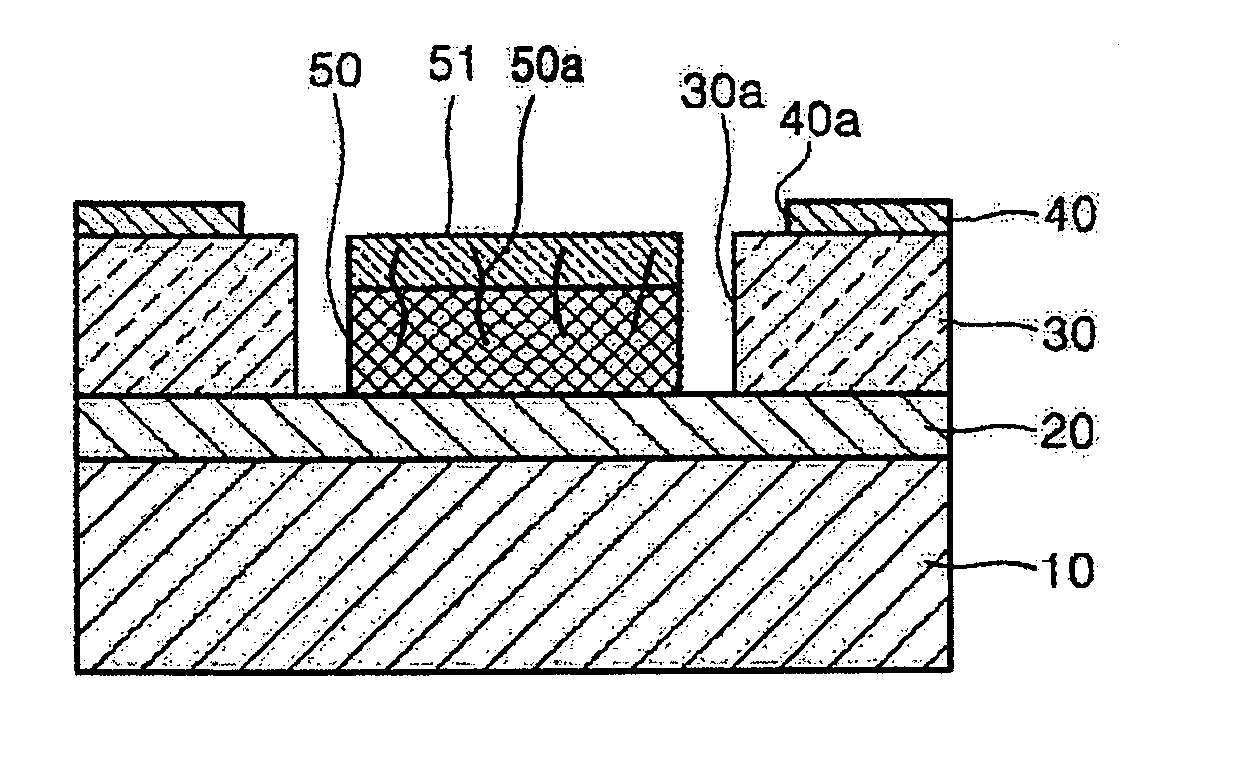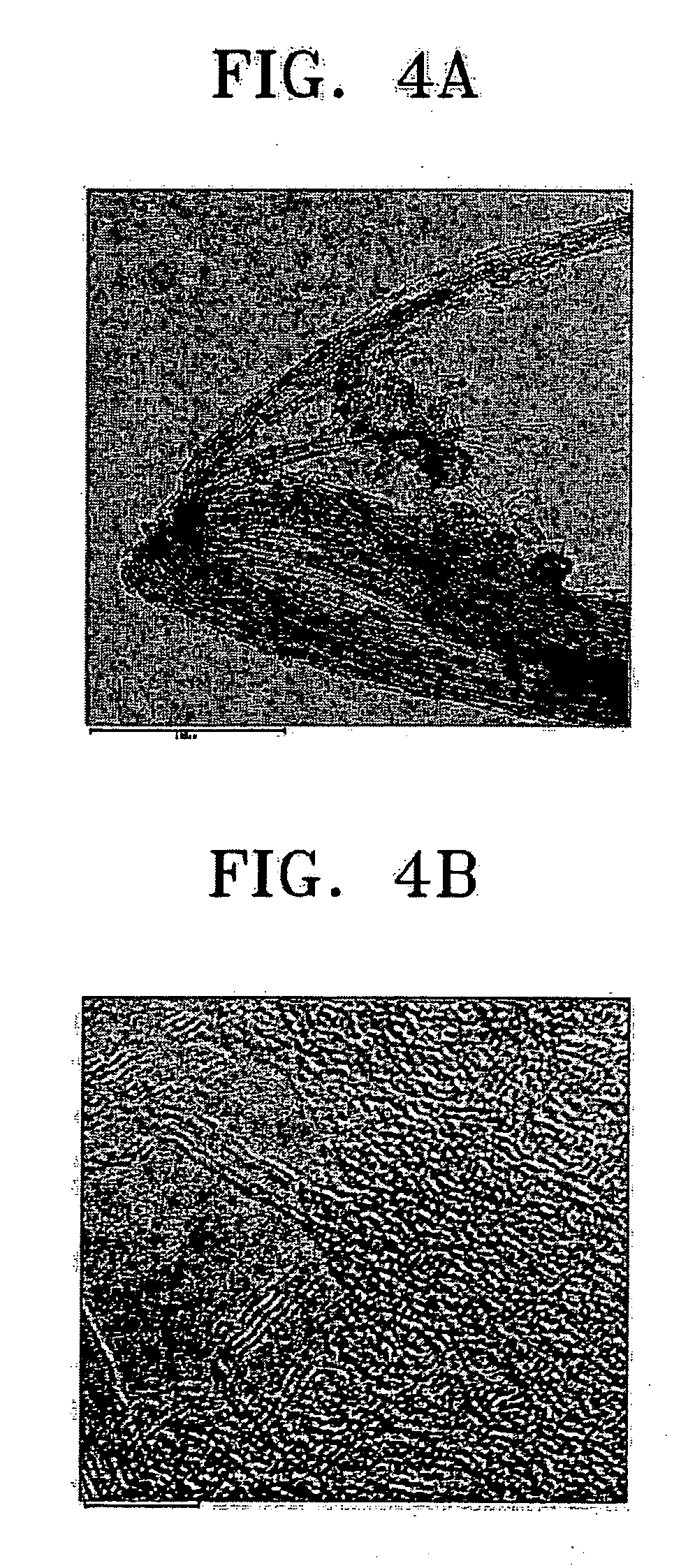Field emission device (FED)
- Summary
- Abstract
- Description
- Claims
- Application Information
AI Technical Summary
Benefits of technology
Problems solved by technology
Method used
Image
Examples
first embodiment
[0044] First Embodiment
[0045] Referring to FIG. 2, a cathode electrode 20 is formed on a substrate 10, and a gate insulating layer 30 is formed on the cathode electrode 20. A through hole 30a to receive a CNT emitter 50 is formed in the gate insulating layer 30, and the CNT emitter 50 to emit electrons is formed at the bottom of the through hole 30a. The CNT emitter 50 is formed on a portion of the cathode electrode 20 that is exposed through the bottom of the through hole 30a. The CNT emitter 50 includes a plurality of CNTs 50a and can further include a conductive material, for example, Ag particles, for efficiently supplying currents to the CNTs 50a.
[0046] A stabilizer layer 51 to stabilize the emission from the CNTs while protecting the CNTs is coated on the CNT emitter 50. The stabilizer layer 51 permits the emission of electrons from the CNTs 50a and covers the CNTs 50a on the surface of the CNT emitter 50. An example of the stabilizer layer 51 includes any one material or a m...
second embodiment
[0049] Second Embodiment
[0050] Referring to FIG. 3, a cathode electrode 20 is formed on a substrate 10, and a gate insulating layer 30 is formed on the cathode electrode 20. A through hole 30a to receive a CNT emitter 50 is formed in the gate insulating layer 30, and the CNT emitter 50 to emit electrons is formed at the bottom of the through hole 30a. The CNT emitter 50 is formed on a portion of the cathode electrode 20 that is exposed through the bottom of the through hole 30a. The CNT emitter 50 includes a plurality of CNTs 50a and can further include a conductive material, for example, Ag particles, for efficiently supplying currents to the CNTs 50a.
[0051] Stabilizer layers 51a for stabilizing the emission from the CNTs 50a are coated on the surfaces of the CNTs 50a. Examples of the stabilizer layers 51 a include SiO2, MgO, TiO2, BN, RuOx, and PdOx. In addition, the stabilizer layer 51a is formed to a thickness of 1 to 100 nm in order to permit the emission of electrons.
[0052] ...
third embodiment
[0078] Third Embodiment
[0079] Referring to 9, a cathode electrode 20 is formed on a substrate 10, and a gate insulating layer 30 is formed on the cathode electrode 20. A through hole 30a to receive a CNT emitter 50 is formed in the gate insulating layer 30, and the CNT emitter 50 to emit electrons is formed at the bottom of the through hole 30a. The CNT emitter 50 is formed on a portion of the cathode electrode 20 that is exposed through the bottom of the through hole 30a. The CNT emitter 50 includes a plurality of CNTs 50b that are grown on the cathode electrode 20.
[0080] Stabilizer layers 51b for stabilizing the emission from the CNTs 50b are coated on the upper ends of the CNTs 50b, which are perpendicularly grown on the cathode electrode 20, in other words, the emission ends of the CNTs 50b. An example of the stabilizer layer 51b includes any one material or a mixture of at least two materials selected from a group formed of SiO2, MgO, TiO2, BN, RuOx, and PdOx. In addition, the...
PUM
 Login to View More
Login to View More Abstract
Description
Claims
Application Information
 Login to View More
Login to View More - R&D
- Intellectual Property
- Life Sciences
- Materials
- Tech Scout
- Unparalleled Data Quality
- Higher Quality Content
- 60% Fewer Hallucinations
Browse by: Latest US Patents, China's latest patents, Technical Efficacy Thesaurus, Application Domain, Technology Topic, Popular Technical Reports.
© 2025 PatSnap. All rights reserved.Legal|Privacy policy|Modern Slavery Act Transparency Statement|Sitemap|About US| Contact US: help@patsnap.com



